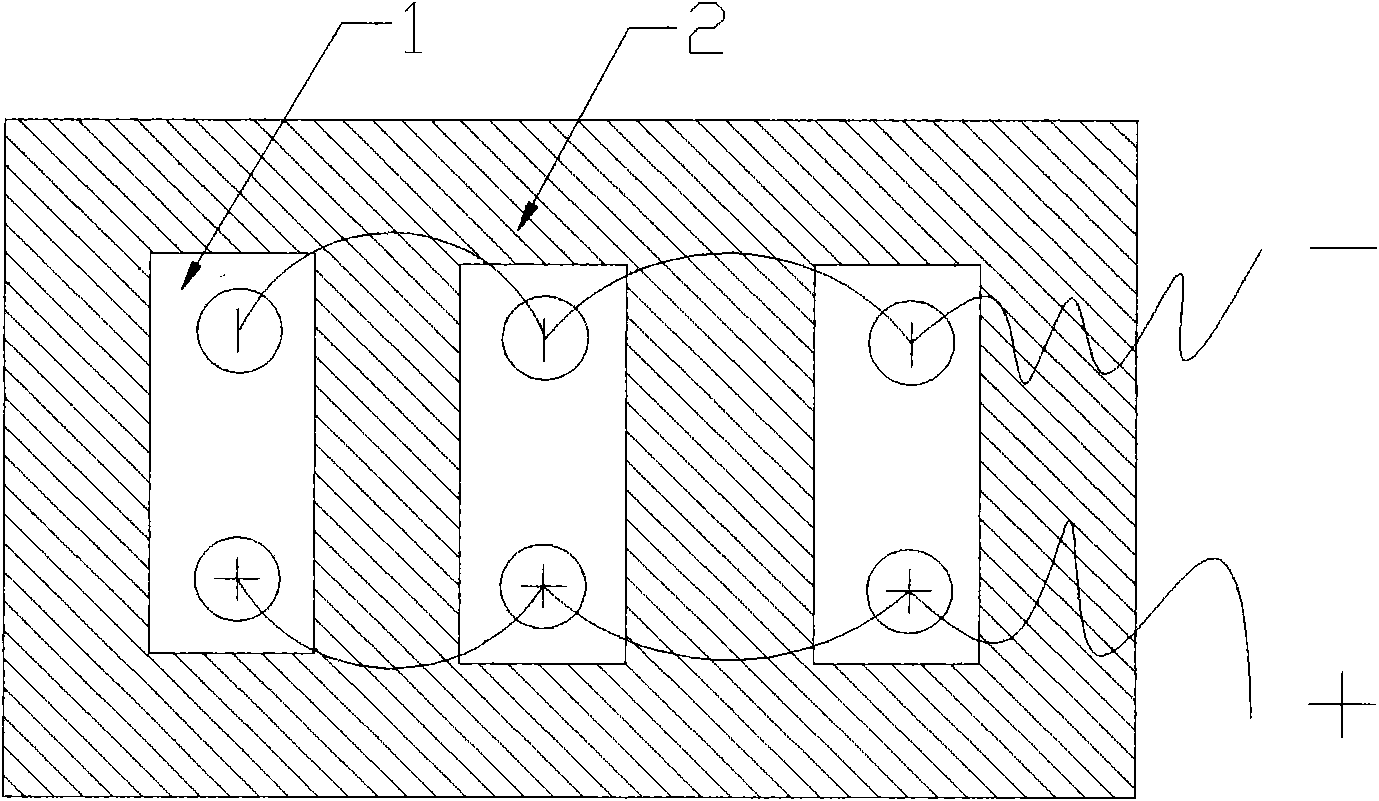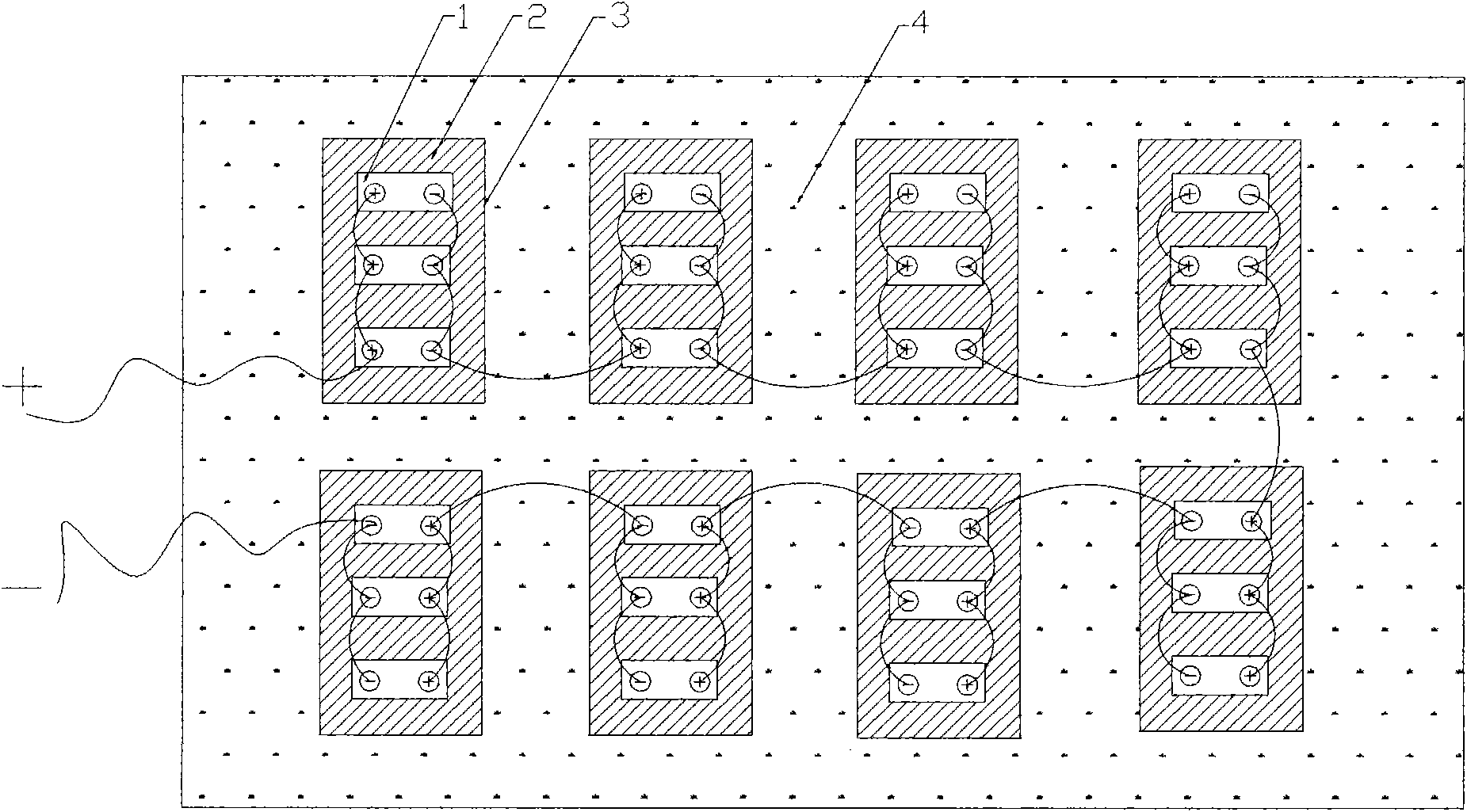Heat-dissipating method of power lithium battery
A heat dissipation method and lithium battery technology, applied to circuits, electrical components, secondary batteries, etc., can solve the problems of inconvenient maintenance, high cost, and poor effect, and achieve the effects of convenient maintenance, low production cost, and simple manufacturing process
- Summary
- Abstract
- Description
- Claims
- Application Information
AI Technical Summary
Problems solved by technology
Method used
Image
Examples
example 1
[0014] 1. Select three 3.2V10Ah lithium-ion battery cells and connect them in parallel to form a 3.2V30Ah battery module A, and make a battery module B in the same way;
[0015] 2. Weigh the heptadecyl carbon wax material and the Al / C composite material with a mass ratio of 78:22, first heat and melt the paraffin, then add the Al / C composite material under high-speed stirring at 880 rpm, and continue stirring for 20 minutes. The obtained phase transition point is paraffin / (Al / C) composite material, and its phase transition point is 49°C;
[0016] 3. According to the experimental test and simulation data, the heat Q released by the battery module A before and after 3C discharge can be obtained dis(cell) , calculate the mass M of the paraffin / (Al / C) composite material according to the aforementioned formula (1) (PCM) , and fill the paraffin / (Al / C) composite material into the gap between the cells of the battery module A according to this mass, see figure 1 , wherein 1 is a lit...
example 2
[0022] According to the expression of Example 1, the difference is that the phase change material is changed to GMB / graphite composite material, wherein the mass ratio of GMB to graphite is 65:35, and the phase transition point is 62.1°C. Graphite was added under high-speed stirring at 850 rpm, and stirring was continued for 45 minutes. In this example, the measured instantaneous temperature of battery module A before and after 3C discharge is 30.7°C and 57.2°C, and the temperature rise is 26.5°C, which is 9.3°C lower than that of battery module B (35.8-26.5=9.3).
[0023] In this example, the mass percentage of GMB and graphite in the phase change material is changed to 60:40, the phase transition point is 55°C, and the temperature rise of the battery before and after discharge is measured to be 24.7°C; the mass percentage of GMB and graphite is changed to 80: 20. The phase transition point is 65°C, and the temperature rise of the battery before and after discharge is measure...
example 3
[0025] Select 24 3.2V10Ah lithium-ion battery cells, and use the "three-in-eight-series" mode to form a 25.6V30Ah battery pack. Referring to the method in Example 1, the paraffin / (Al / C) composite material (mass ratio 83:17) between battery cells, and the GMB / graphite composite material (mass ratio 60:40) described in Example 2 is filled between battery modules, see figure 2 , where 1 is a monomer, 2 is a paraffin / (Al / C) composite material, 3 is a battery module, and 4 is a GMB / graphite composite material. When the battery is discharged at a high current of 12C, when the temperature reaches the phase change point of the paraffin / (Al / C) composite material, the phase change material absorbs the heat released by the monomer, and undergoes a phase change by itself until it is completely transformed into another phase. After the phase change process is complete, the temperature continues to rise, and when it reaches the phase change point of the GMB / graphite composite material, the...
PUM
| Property | Measurement | Unit |
|---|---|---|
| Phase transition point | aaaaa | aaaaa |
| Phase transition point | aaaaa | aaaaa |
| Phase transition point | aaaaa | aaaaa |
Abstract
Description
Claims
Application Information
 Login to View More
Login to View More - R&D
- Intellectual Property
- Life Sciences
- Materials
- Tech Scout
- Unparalleled Data Quality
- Higher Quality Content
- 60% Fewer Hallucinations
Browse by: Latest US Patents, China's latest patents, Technical Efficacy Thesaurus, Application Domain, Technology Topic, Popular Technical Reports.
© 2025 PatSnap. All rights reserved.Legal|Privacy policy|Modern Slavery Act Transparency Statement|Sitemap|About US| Contact US: help@patsnap.com



